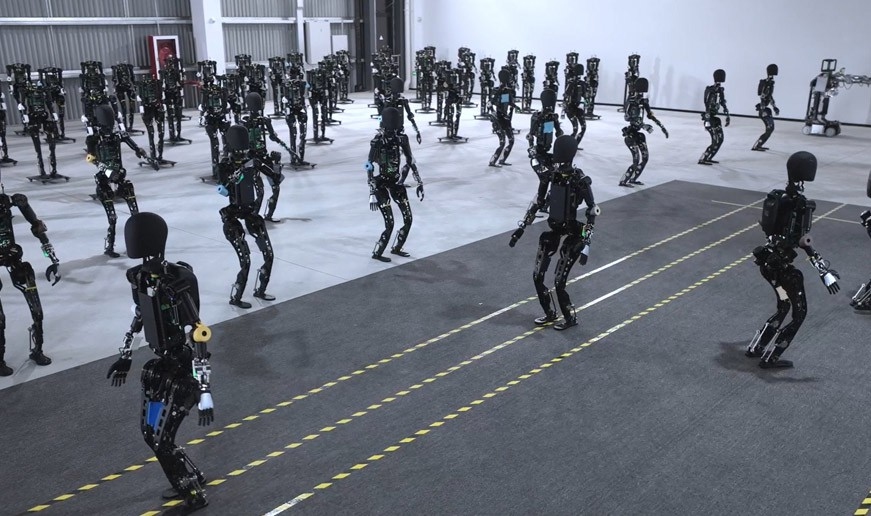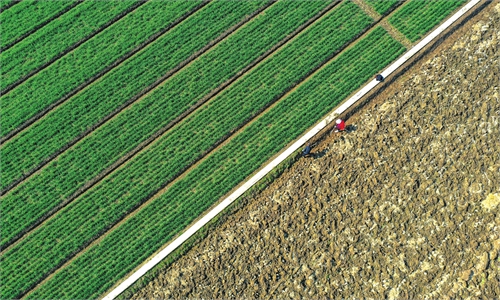
Agibot, a Chinese robotics start-up launched in February 2023, shows its mass-produced robots in a video. Photo: Agibot
Agibot, a Chinese robotics start-up launched in February 2023, has stirred significant excitement in the industry with its announcement of having already begun mass production of general-purpose robots, while Tesla, the US electric car giant, envisions launching mass production of humanoid robots by 2026.
"As 2024 closes, Silicon Valley startup Figure AI is delivering its first AI robots, and a Chinese startup coming directly for the Tesla Optimus is already mass producing advanced AI robots," wrote a tech blog mikekalil.com.
Titled "Commercial mass production ahead of Tesla? Agibot robot delivered nearly 1,000 general purpose robots by the end of the year," Chinese media 21st Century Business Herald wrote, highlighting the excitement in the industry for Agibot's announcement.
Agibot, also known as Zhiyuan Robotics, shared footage of its manufacturing facility on its official website, which reportedly has produced at least 962 humanoid robots so far.
In its 4:02-minute video, Agibot showcases various stages of the robotic production line at its Lingang Fengxian factory in Shanghai, including inventory shelving, component assembly, component testing, aging tests and performance testing. The production line features self-manufactured humanoid robots working in collaboration with human workers for tasks such as inventory shelving and component testing.
Moreover, the company has established what it calls a "data collection factory" for real-world data gathering. This includes training scenarios such as folding clothes, organizing, cleaning and doing the laundry.
Elon Musk, the founder and CEO of Tesla and SpaceX, said in an X post in July that "Tesla will have genuinely useful humanoid robots in low production for Tesla internal use next year and, hopefully, high production for other companies in 2026."
Agibot's mass production of robots has instilled confidence in its investors regarding high revenue projections for next year and signals an exciting development for the market, industry observer Hong Shaodun told the Global Times on Thursday.
He noted that humanoid robots have evolved from laboratory prototypes to tangible products, with this year's robots entering a phase of increased intelligence and versatility.
Robots' hardware has reached a notable level of standardization, according to Hong, who explained that whether from Tesla or other brands, multiple products have been showcased since the second half of the year. There are no significant differences in hardware among them. The only standout feature may be the dexterous hand.
Although Chinese robotics companies have announced mass production ahead of firms like Tesla, essentially, both nations, making the most significant progress in humanoid robotics, are advancing simultaneously, Wei Jiaxing from Beijing-based National and Local Co-built Embodied AI Robotics Innovation Center, told the Global Times.
US tech companies, such as Tesla and NVIDIA, have certain advantages in areas like precise upper limb manipulation and operational capabilities, as well as in high-end chip manufacturing and cloud computing services. Meanwhile, Chinese companies excel particularly in motion control and the exploration of advanced AI models, as well as a variety of application scenarios, Wei noted.
At the end of 2023, China's Fourier Intelligence became the first leading humanoid robot player to officially announce "mass production." This year, the company revealed that its first bipedal humanoid robot, the GR-1, has been delivered in over 100 units across dozens of scenarios, the 21st Century Business Herald reported.
Jiao Jichao, a vice president and executive dean of the Research Institute at UBTech Robotics, a Shenzhen-based maker of humanoid robots, disclosed that during the OEM training process for Walker S, preparations are underway for small-scale mass production by the end of the year.
Some industry insiders believed that the "mass production of humanoid robots" does not have a clear boundary. The key issue is whether customers truly have the willingness to purchase such robots, or whether there are scenarios that provide for the large-scale use of humanoid robots.
"We hope that the technology and products will achieve a level of maturity and excellence. Only on this foundation does it make sense to enhance real mass production capacity," Wei said.
Compared with other global competitors like the US, China is better positioned to achieve higher output of humanoid robots at lower costs, following the gradual maturation of technology and products in this field, as well as the advantages of its manufacturing supply chain, Wei said.
When asked about the impact of the technological blockade on China's industrial development amid the competition between China and the US, Wei stated that China is dedicating significant efforts to independent research and development in robotics.
He also mentioned that specialized chips designed for robotics are also one of targeted areas for his National and Local Co-built Embodied AI Robotics Innovation Center.
The focus for next year in this industry will be on expanding practical applications in specific scenarios, which could further enhance the generalization capabilities of humanoid robots, Hong told the Global Times. However, the industry insider noted that achieving rapid breakthroughs in a short time remains quite challenging due to technical hurdles, such as efficiency and stability issues that need to be addressed.




